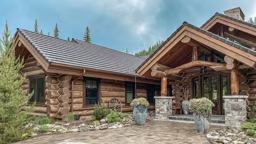
Photo: Rogatnev - stock.adobe.com
Let’s face it – borrowing money makes the world go ’round. With that, homeownership usually means obtaining a loan from a bank, credit union or other source. Taking the plunge involves an examination of one’s finances, and a complex road to loan closing is common. However, leveraging some wise advice in your approach can reduce the stress and push the program along to the happy day when papers are signed and the deal is done.
To start, one of the best things you can do is to choose an experienced lending professional who will serve as a trusted advisor — one who is adept at the intricacies of the mortgage process and can empathize with the fact that this is likely uncharted territory for their clients. Above all else, your lender needs to understand the critical path and unique timing that comes with log home construction.
Where Do You Start?
As Executive Vice President at The Federal Savings Bank, Robert Jones has more than two decades of home lending experience. He currently runs an entire division of the bank dedicated to helping customers find appropriate financing solutions for their log home projects. Robert and the team of bankers at TFSB work with dozens of log home dealers and builders nationwide.
His team believes the financing component should be a part of the discussion from the beginning. Practicality goes hand in hand with realizing one’s log home dream, and knowing that the loan amount, monthly payment and budget are achievable reduces the potential for disappointment.
It’s best to know the amount of a loan that you qualify for and what you want to pay per month, and then plan around that rather than going back to the drawing board. For example, you wouldn’t want to find a plan you love, only to find out the log package will be $200,000 along with a $600,000 cost to build, and you only qualify for $450,000. Log home dealers like to work with qualified borrowers and often need to know that their customer has talked to a lender and the project will get to the finish line.
To facilitate the paperwork, the loan application needs to provide a good picture of the applicant’s borrowing power and must be accompanied by supporting documentation, like paystubs or W-2 forms for income verification, or, if you’re self-employed, two years of income tax returns. If you are retired, lenders also may ask for tax returns because they can estimate Social Security income in qualifying for a loan amount. Most lenders have an online preapproval option, and they can then request the information needed based on the borrower’s particular scenario.
“We tell customers to start the financing process roughly eight weeks before they want to begin construction,” Robert says. “The biggest hurdle, outside of the credit and underwriting process, is getting the appraisal done, and that usually takes two weeks. You don’t want to have to rush through the process.”
The main reason the appraisal component has been seen as an obstacle is due to a lack of sales of other log homes in the designated radius (aka, comparables or “comps”) — a reality that makes it difficult for an appraiser to derive a reasonable market value for the home a client intends to build. But there is hope. Recent guidelines from Fannie Mae (Federal National Mortgage Association), for example, provide for adjustments based on other types of homes, usually conventionally built, to allow the appraiser to reach a sustainable valuation.
But there’s another reality that can create snags while trying to secure a mortgage for your log home build, and that’s a lack of knowledge about the process by the lending community at large. Some mortgage providers are diving into the log home market without any experience in construction or the aspects of lending that relate specifically to log homes — and that unfamiliarity has the potential to derail construction.
Where this lack of understanding can really cause issues for you, the borrower, is in how and when the money is disbursed throughout the construction timeline — steps in the process known as “draws.” For a lender used to funding conventional-home projects, log home construction can be very different.
Think of performing your due diligence on the lender just as you would the log home dealer and builder. Finding the right bank can make all of the difference in the world when it comes to purchasing your home. Take a look online for lender reviews and also ask your banker about their experience with financing log homes.

Photo: @Pormezz / Adobe Stock
What Are Your Options?
Lenders routinely offer both fixed and variable rate mortgage options, and customers choose the program that will work best for them, now and in the years to come. Rising interest rates have impacted the borrowing capacity of consumers, and prospective homeowners feel the brunt of the increased cost reflected in their proposed project budget, loan amount and monthly payment. Nevertheless, those considering a log home may often adapt to the economic environment by moving forward with a basic or primary home with an eye to the future.Robert offers this perspective: “Log home buyers tend to be less sensitive to interest rates as they have been planning and saving for some time prior to making their decision. The log home buyer is usually prepared financially to purchase exactly what they want. We do, on occasion, find buyers who will build the main section of their home first and then construct an additional after the fact.”
What Do You Need to Qualify?
The underwriting process may vary slightly from one lending institution to another, but Robert sees a consistent approach to loan qualification.For construction debt, they consider a maximum debt-to-income ratio range of 43 to 45 percent of gross annual income, and that includes all debt obligations the borrower has. They focus on the overall debt picture of the customer based on what they have out there. Also, depending on the lender, most conventional mortgages look at a minimum credit score of 660 or above for new construction, although some are higher. Job stability is important as well, and that means a two-year average for the most part. Of course, some people have several jobs before they are 30 years old – so the real key is stable income.
What Should You Never Do?
One thing every borrower should avoid no matter his or her financial status is taking on new debt during the loan approval process. From application to closing, borrowers should refrain from obtaining other lines of credit that will result in an inquiry on the credit report that is being used to qualify for their home loan.
Lenders monitor credit throughout the underwriting process. It’s called "undisclosed credit monitoring," and customers need to be aware of this situation.
“I have seen a few instances over my 25-year career where a borrower had gone through the entire loan process all the way to closing and credit monitoring alerted us that a customer had their credit pulled. Customers have gone out and financed a car, a boat, even furnishings for their new log home. In some cases, this new payment can be enough to disqualify a borrower. Imagine going all the way through the home buying and financing process only to lose your opportunity for financing at the very end!” says Robert.
Information is power – particularly when it comes to getting the money you’ll need to finance your log home build. Finding that trusted advisor and then working through various scenarios that result in a healthy balance between affordability and practicality will lead to a satisfying, less stressful mortgage experience.
What Is the Lender Looking For?
What do you need to successfully borrow money from a lending institution? Credit criteria usually include the following:
- A satisfactory debt-to-income ratio (the main focus when lenders are qualifying customers). Most lenders will not exceed a ratio of 45% with construction lending.
- Credit score verified through a credit report. 660 or above is traditionally needed for construction lending.
- A minimum of 5% down (can be cash or equity depending on the transaction).
- Two years of employment history with no gaps. Same field preferred.
- Source of any cash down payment. If a gift is involved, a letter describing the details must be provided by the borrower. The gift is not expected to be repaid to the giver. All funds to close must be documented.
What Do I Need to Show a Potential Lender?
Have these items available when it’s time to apply for log home financing:
- Current personal financial statement
- Two most recent yearsof personal tax returns (complete with schedules)
- Final blueprints/house plans
- Construction cost estimate
- Construction contract (if available)
- Verification of available cash (bank or brokerage statements)
- Sales contract (if applicable)

Photo Credit: fotolia.com/lofik
Why Is a Log Home Construction Loan Different Than Other Types of Loans?
If you’re in the homebuying market, you’re at least somewhat familiar with how mortgage loans work. But if you’re planning to build a custom home — specifically a log home — the process may be a bit unfamiliar.Short-term construction loans operate a little differently than a standard mortgage. A construction loan pays for the materials and labor needed to build your home. These loans are made for periods from six to 18 months and have higher interest rates than mortgage loans because, as far as banks are concerned, they carry more risk. Lenders may require a deposit of up to 20 percent because of that risk. Typically, you pay only the interest amount until the home is completed and then the mortgage takes over (assuming you have a construction-to-permanent loan), adding the construction loan principal into that mortgage.
Before granting a construction loan, lenders review the project and evaluate the builder’s ability to complete the home according to the plans, budget and schedule. Once the loan is approved, the lender disburses the money according to a draw schedule, which releases funds based on determined milestones and work completed.
This is where loans for log homes can get a little tricky. The materials used in conventional construction are interchangeable with any other home; in other words, if a project falls through, a builder can return materials to his local supply store or transfer them to another project.
Logs are cut for your specific house and can’t simply be restocked and used for another house in the future. Because of this risk, log home providers expect to be paid a substantial down payment before cutting and shipping the logs, but lenders typically don’t like to release funds until materials are accepted at the job site.
This jam can be avoided by choosing a lender familiar with log home construction, or by ensuring your lender understands the need for the log package deposit as part of the draw schedule.

The Money You Need Is a Click Away
Finding a lender who understands the ins and out of log home construction can be a challenge. Big banks are too large to work with you personally, and small, regional banks often don’t want the risk. That’s why Log & Timber Home Living has partnered with The Federal Savings Bank* to bring you Log & Timber Loans — a unique financing option created by people who not only understand log homes, but also want to work with log home buyers. Apply today!
*The Federal Savings Bank is a federally chartered bank serving all 50 states with representatives experienced in offsite construction methods, including log, timber frame, modular and panelized systems, as well as conventional construction, remodeling and refinancing products and VA loans.








_11868_2024-09-17_08-44-256x288.avif)


